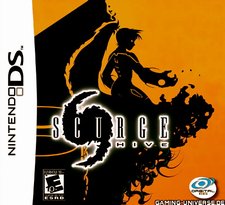 Within the context of the gaming realm, Scurge: Hive is old news.
Within the context of the gaming realm, Scurge: Hive is old news.
Released in late Oct. 2006 by independent publisher SouthPeak Interactive, Scurge: Hive was met with mixed critical reception, no publicity and extremely modest sales figures. So why revisit this obscure, unrecognized game more than 15 months after it hit store shelves?
Quite simply, because it rocks.
Scurge: Hive introduces players to Jenosa Arma, a female bounty hunter commissioned to investigate a high security research lab on the planet Inos from which a distress signal was sent 48 hours ago. Scientists there were tasked with studying the Scurge, a virulent plague with dangerous manipulative properties. Fearing the worst, Jenosa has been assigned to recover any surviving research.
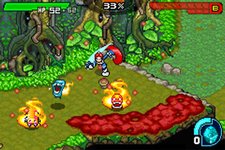 Obviously, the entire premise of Scurge: Hive is a respectful nod to Nintendo’s own Metroid series, as is the character herself. Similar to Samus Aran, Metroid’s first lady of galactic ass-kicking, Jenosa Arma wears an experimental prototype battle suit equipped with the ability to fire top-secret projectiles by giving a mere throwing motion. The suit can be upgraded with new firing abilities and power-ups.
Obviously, the entire premise of Scurge: Hive is a respectful nod to Nintendo’s own Metroid series, as is the character herself. Similar to Samus Aran, Metroid’s first lady of galactic ass-kicking, Jenosa Arma wears an experimental prototype battle suit equipped with the ability to fire top-secret projectiles by giving a mere throwing motion. The suit can be upgraded with new firing abilities and power-ups.
Metroid fans should feel right at home, but others should know that Scurge: Hive has more than enough unique attributes to distinguish itself as a competent, original action adventure title. At no point does Scurge: Hive feel like a derivative Metroid clone. It achieves its own atmosphere and gameplay despite the expectations resulting from its Metroid similarities, which is an accomplishment itself.
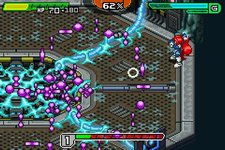 Speaking of the gameplay, Scurge: Hive can be downright manic. Shooting beams as fast as possible is a catastrophic strategy, as certain enemies are vulnerable to, and actually helped by, certain beams. For example, firing Jenosa’s electric beam at a small monster may kill the organism faster than other beams, but firing the same beam at an infected robot will actually increase the enemy’s HP. Players must learn the strengths and weaknesses of each beam, as well as which enemies are affected and benefitted by them.
Speaking of the gameplay, Scurge: Hive can be downright manic. Shooting beams as fast as possible is a catastrophic strategy, as certain enemies are vulnerable to, and actually helped by, certain beams. For example, firing Jenosa’s electric beam at a small monster may kill the organism faster than other beams, but firing the same beam at an infected robot will actually increase the enemy’s HP. Players must learn the strengths and weaknesses of each beam, as well as which enemies are affected and benefitted by them.
Making her travels even more perilous, Jenosa herself becomes infected with the Scurge. Because of her infection, players are on a constant timer, of sorts, as Jenosa’s health drains by the second. So while fighting off enemies, solving puzzles and finding hidden door keys, players must also find save stations that cleanse Jenosa of her Scurge, restoring her health and resetting the timer.
Upon stepping away from the save station, however, her infection begins anew. This adds dramatically to the vigorous action of the game, as well as its intense pacing.
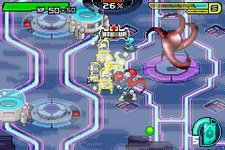 Despite its addictive nature, the gameplay is far from perfect. Jenosa can fire in eight directions: up, down, left, right and the diagonals. While this inherently limited aiming mechanism is already an obstacle, the Nintendo DS hardware doesn’t make things any easier. The DS directional pad can make aiming a laborious process, as players may find they simply cannot shoot an enemy without compromising their position. This eight-directional limitation also hinders the otherwise quick and nimble Jenosa’s jumping precision, sometimes making simple platforming harder than it should be.
Despite its addictive nature, the gameplay is far from perfect. Jenosa can fire in eight directions: up, down, left, right and the diagonals. While this inherently limited aiming mechanism is already an obstacle, the Nintendo DS hardware doesn’t make things any easier. The DS directional pad can make aiming a laborious process, as players may find they simply cannot shoot an enemy without compromising their position. This eight-directional limitation also hinders the otherwise quick and nimble Jenosa’s jumping precision, sometimes making simple platforming harder than it should be.
Scurge: Hive was originally developed for, and also released on, the Game Boy Advance. And it shows; the game doesn’t push the DS hardware and inexplicably looks slightly better on the GBA.
But that’s not to say Scurge: Hive is an ugly game. Quite the contrary, it is very pleasing visually. The colors are explosively vibrant, the backgrounds are detailed and the animations are spectacular. It calls upon the dusty criteria we used to define “beautiful graphics” during the SNES era, and it serves as a reminder that pretty games don’t necessarily need to be in 3D.
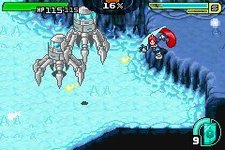 The game’s animations deserve specific mention, particularly those of the protagonist. Jenosa Arma is a well designed character, and she is remarkably well animated. Her absurdly long ponytail whips about the screen as she blasts through her environments, circling around her body when she flips and bouncing from side to side when she runs. The strength of the charming Jenosa, an original character, also significantly improves the experience. Scurge: Hive is perhaps most noteworthy because it is an original IP, a welcome breath of fresh air our industry takes far too infrequently.
The game’s animations deserve specific mention, particularly those of the protagonist. Jenosa Arma is a well designed character, and she is remarkably well animated. Her absurdly long ponytail whips about the screen as she blasts through her environments, circling around her body when she flips and bouncing from side to side when she runs. The strength of the charming Jenosa, an original character, also significantly improves the experience. Scurge: Hive is perhaps most noteworthy because it is an original IP, a welcome breath of fresh air our industry takes far too infrequently.
Though the game released on both Nintendo handhelds, the DS version is clearly the better choice. The visual discrepancy between the two is quite minimal, and there are no touch controls; Jenosa is controlled entirely with the directional pad and buttons. But the strength of the DS version lies with its dual screens. Some of the environments Jenosa must explore are massive and almost labyrinthine in their design. Dual screens afford players constant view of their map, which can come in handy in later levels.
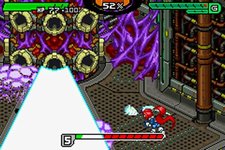 Most players will have between 10 and 12 hours of gameplay with Scurge: Hive, a meaty game for a handheld title. But there isn’t much to do after the game ends. Aside from some unlockable costumes and content, Scurge: Hive is very much a single-player game in the old-school vein. No multi-player, no frills. Players should consider this, as well as their individual tastes, before committing to a purchase.
Most players will have between 10 and 12 hours of gameplay with Scurge: Hive, a meaty game for a handheld title. But there isn’t much to do after the game ends. Aside from some unlockable costumes and content, Scurge: Hive is very much a single-player game in the old-school vein. No multi-player, no frills. Players should consider this, as well as their individual tastes, before committing to a purchase.
But especially at it’s current price tag, Scurge: Hive is an under-exposed gem, an absolute steal for “hardcore” DS owners.
Given our industry’s tendency to rely on its established icons, it is immensely refreshing to assume the role of a new character, even if she is heavily influenced by some of those icons. Despite its flaws, Scurge: Hive is a polished, surprisingly slick package.
Undeniable atmosphere, masterful music, inventive boss battles and fun gameplay get Scurge: Hive three stars out of four.

